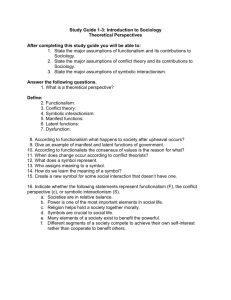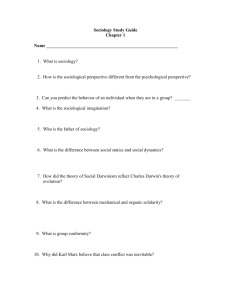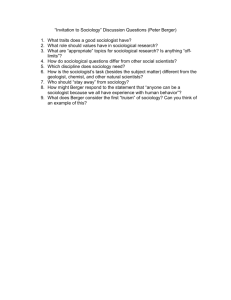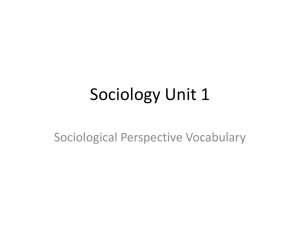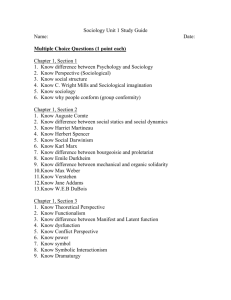sociological perspective
advertisement
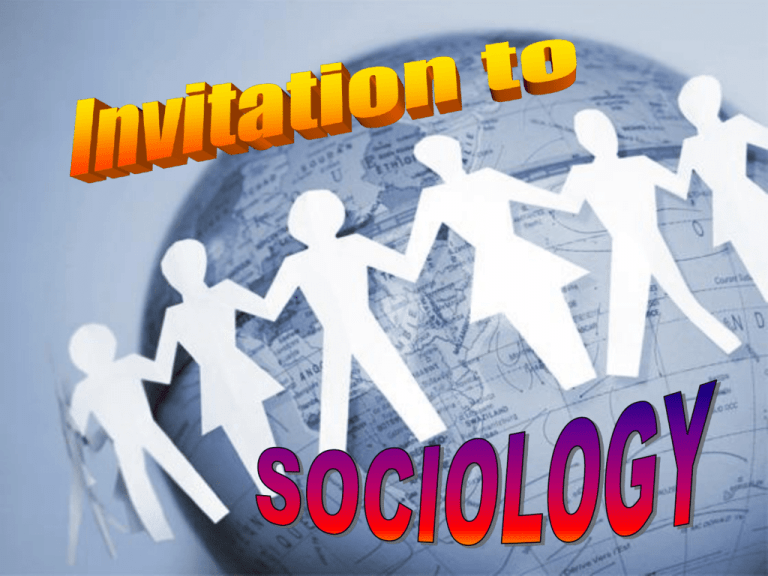
Take five minutes and write down your reactions to… Rules defining appropriate and inappropriate behavior; ways of behaving in specific situations; guides people to behave similarly in similar circumstances; ingrained and we are typically unaware of them until they are broken Expected Behavior • Stand in line when buying your lunch Violation • Cutting in line • Earning your own income through work and effort • Stealing from others What happens when are violated? • Norms are learned and accepted • Groups teach norms through use of sanctions – Rewards/punishments used to encourage conformity • Sanctions are used – Humiliation; people staring – Asked to move back to the end of the line/guilt – Jail time, fines, etc. • The study of modern human social behavior as a group (psychology – individual) • Examine the patterns of behavior that are shared by members of a group (social factors that influence our actions) • The sociological perspective focuses on the group not the individual – Young men join gangs because they have been taught by their society to be “masculine” NOT a young man joins a gang to prove his toughness PERSPECTIVE IS EVERYTHING… • SOCIOLOGICAL PERSPECTIVE: Looks at the behavior of GROUPS not individuals SOCIAL STRUCTURE and the study of social behavior help to create a social structure. - An environment that prescribes/dictates members of a group to behave in a certain way. I can’t determine how you will act when you’re alone, but I can make predictions as to how groups of people typically behave. • When groups form, individual personalities no longer solely dictate the behavior of an individual • Because of a group environment/setting as individuals we behave differently then we might otherwise if we were alone - Example: 2008 World Series Champions Philadelphia Phillies How many of you are the exact same • Understanding how social forces person with your friends as you are impact our decisions as individuals with your family? • Helps you make sound decisions Or (sometimes influenced by the How many of you act way social structure butthe at same least you inare school as you do on the weekends aware of that) with your friends (language, demeanor, attitude, clothes, etc.) Auguste Comte • • • • • • 1798-1857 Considered “Father of Sociology” Coined the term sociology Create a science to study society Used scientific observation Positivism – science based on knowledge that we can be sure about • Studied social statics (stability) and dynamics (social change) • Positive Philosophy - book Harriet Martineau • 1802-1876 • English • Translation of Comte’s work • “mother of sociology” • Contributed to sociological research methods, political economy, and feminist theory • Book – Society in America Herbert Spencer • 1820-1903 • English • Without interference from people, natural social selection would ensure survival of the fittest. • Used Theory of Social Darwinism – Opposed social reform – Allow nature of wealth/poverty to take its course – This will help develop/structure society the way it is meant to be Karl Marx • 1818-1883 • German • Believed social scientists should try and change the world/society not just study it • Studied class conflict – Believed a classless society would prevail (communism) – Bourgeoisie/capitalists – own the means of production (money, factories, etc.) – Proletariat - workers Emile Durkheim • 1858-1917 • French • Society exists because of consensus/agreement – Pre-industrial society – mechanical solidarity (based on consensus) – Industrial society – organic solidarity (based on each person having specialized roles, interdependent upon one another) • Developed sociological research tools – Observation – statistics Max Weber • 1864-1920 • German • The Protestant Ethic and the Spirit of Capitalism – book • Verstehen – putting yourself in someone else’s shoes • Rationalization Jane Addams • • • • 1860-1935 American Social reformer – seeking social justice Imbalance of power among social classes and its effects of industrialism on poor • Not considered a sociologist while living WEB DuBois • 1868-1963 • American • Social structure of African American communities C. Wright Mills • American sociologist • sociological imagination - being able to connect individual experiences and societal relationships Charles Cooley • American psychologist, sociologist, and educator • demonstrated that "personality emerges from social influences, and that the individual and the group are complementary aspects of human association” AKA… concept of the looking glass self, which is the concept that a person's self grows out of society's interpersonal interactions and the perceptions of others Herbert Blumer • American sociologist • 1937 Known as the founder of the symbolic interactionism concept (Man and Society) – Humans behave according to the meanings that things and events have for them. – Individual meanings of things and events stem from interaction with others. – Meanings entail interpretation rather than simple literal compliance with standardized expectations • His earlier work included Movies and Conduct (1933) and Movies, Delinquency, and Crime (1933). A collection of essays concerning social organization and industrialization formed from the perspective of social interactionism Ralf Gustav Dahrendorf • 1959 - Most influential work on social inequality is Class and Class Conflict in Industrial Society. – The problem of inequality in modern, or postcapitalist, societies – Neither structural functionalism nor Marxism alone provides an acceptable perspective on advanced society • Criticized and wanted to challenge the “false, utopian representation of societal harmony, stability, and consensus by the structural functionalist school” George Mead • American sociologist • One of the founders of social psychology and the American sociological tradition in general • Most influential idea was the emergence of mind and self from the communication process between organisms, discussed in Mind, Self and Society, also known as social behaviorism – Aligns with symbolic interactionism theory • A set of assumptions about the workings of society • Viewed as true by its supporters Sociology has THREE major theories (each has its own followers)…AH AH AHHHH! – To be able to examine a social situation using all three theories is best (gives best understanding) Line up in order of birth date. Youngest (left) to oldest (right) No talking, no pen and paper, no ID’s Theory 1: • Emphasizes the contributions made by each part of society (ex. Family, religion, economics) • Everyone in society has a function in which they seek to fulfill • Societies tend to turn towards a state of stability Birth Order Activity All parts of society/group working together for common goal (functionalism) Theory 1: • Manifest Functions: Intended and recognized consequences • Latent Functions: Unintended and unrecognized consequences • Dysfunction: Negative consequences Theory 2: • Emphasizes conflict and competition (Opposite of Functionalism) • Groups compete to preserve and promote their own special values and interests Theory 2: • As the balance of power shifts in society, change occurs • POWER = The ability to control the behavior of others Women’s movement is shifting power between men and women • Play two rounds of musical chairs, removing a chair each time • From here forward anyone left without a chair when the music stops may share a chair with someone (emphasizes cooperation – functionalism, rather then competition – conflict theory) • How can this game be explained by the theoretical perspectives? – First two rounds illustrate competition = conflict theory (limited resources and the fight for those resources) – Later rounds promote cooperation = functionalism What were the Manifest and Latent Functions of Musical Chairs? Manifest = Demonstrating Theories Latent = Fun Theory 3: What is the symbol? What do you think of seeing this symbol? What/who would you expect to see with this symbol? Where might you see this symbol? How might you behave because of this symbol? Theory 3: • Coined by Herbert Blumer • SYMBOL: anything that stands for something else and has an agreed-upon meaning. – We learn the meaning of symbols by watching others – We use learned meanings to help us imagine how others are going to respond to the same symbol and base our actions accordingly A guest speaker visiting your sociology class described her tour of duty as an army nurse in Vietnam during the height of the conflict. She commented that her parents forbade her to enlist because they felt the war was not a legitimate cause. She was eighteen; she felt free to choose. When she returned home two years later, she faced criticism and ridicule from students on her college campus, as well as from her parents. Thirty years later she has been recognized as a U.S. war hero.

